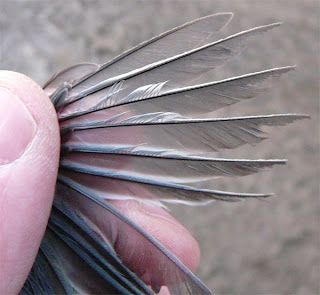Nipped down to Manor Farm Country Park this evening armed with a landing net on a three metre pole, a spot light and some E size bird rings just in case! The evening began cloudy, but before long the cloud had cleared, and it was crystal clear with no wind and the temperature rapidly dropping. Apparently these are not ideal conditions for catching Woodcocks, but we had made the effort to get here, so thought we would give it a go. The first field we looked in was empty other than a huddle of sheep, but in the next field instant success....as we walked into the field two Woodcock immediately took flight, whilst the third sat tight. With the expertise of a seasoned expert Nigel had crept up to it and dropped the net over in no time.
 |
| Adult Woodcock - Manor Farm Country Park |
I have flushed this species from the woods during daylight hours on many occasions, and have even seen them coming off the fields at dawn, but have never managed to catch one...so it was about time!!
 |
| Adult Woodcock - Manor Farm Country Park |
Birds can be aged by a number of features, juveniles show jagged and worn primary tips, rounded tips to the inner 3rd and 4th primaries, rounded alula and the lack of a pale terminal band to the tips of the primary coverts.
 |
| Adult Woodcock - Manor Farm Country Park |
Whereas adults show very little wear to the primary tips, a broad and flattened tip to the inner 3rd and 4th primaries, pointed alula and usually a distinct pale terminal band to the primary coverts, as shown in the picture above.
As we continued our search we were joined by an extremely active Barn Owl circling overhead and screeching, whilst Little Owls fed on the in the sheep grazed pasture. We didn't find anymore Woodcocks but I will certainly be having another go in the future.













